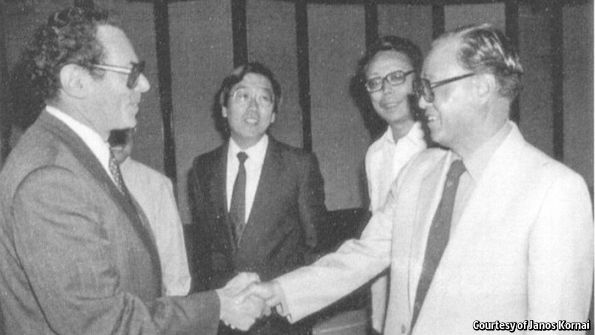 Unlikely Partners: Chinese Reformers, Western Economists, and the Making of Global China. By Julian Gewirtz. Harvard University Press; 389 pages; $39.95. To be published in Britain on January 31st.
Unlikely Partners: Chinese Reformers, Western Economists, and the Making of Global China. By Julian Gewirtz. Harvard University Press; 389 pages; $39.95. To be published in Britain on January 31st.
IN 1985 James Tobin, a Nobel laureate in economics, delivered a talk at a conference in China. Mao had died less than a decade earlier and modern economic concepts, shorn of socialism, were still unfamiliar to many in the country, including the interpreter on this occasion. Struggling to find the right words, she burst into tears. Two conference participants stepped aside after Tobin spoke and, on the spot, devised the Chinese term for “macroeconomic management”. Future interpreters would have it easier.
Chinese officials and academics, especially those with a reformist bent, were acutely aware of their tenuous grasp on economics at the time. Five years earlier, Deng Xiaoping, the country’s paramount leader, had put it bluntly when meeting Robert McNamara, president of the World Bank: “We have lost touch with the world.”
With China’s economic rise now into its fourth decade, it is easy to forget how shaky its footing was at the start of its ascent. It began not just in poverty, but beset by basic uncertainty about how to develop. There was even disagreement over whether development, in so far as it entailed market forces, was the right goal.
The oft-told story is that the Communist Party forged ahead with policy experiments—“crossing the river by feeling for the stones”, as the Chinese reformers’ saying goes—and, little by little, found the ingredients for growth. There is much truth to this. But the role of Western economists in helping shape that journey is missing. “Unlikely Partners” by Julian Gewirtz, a doctoral candidate in Chinese history at Oxford (and an occasional reviewer for these pages), fills that gap. It vividly brings to life China’s economic debates from Mao’s death in 1976 until 1993, by which time the country’s direction was clearer.
The claim is not that Westerners were responsible for China’s development. A large constellation of Chinese reformers deserves the credit for that. Indeed, one of the book’s virtues is that it puts the spotlight on Zhao Ziyang, the Communist Party chief who wound up under house arrest after the 1989 Tiananmen protests. Mr Zhao has been written out of official histories, but his consistent support for bold thinking was critical to China’s success.
Nevertheless, to understand how China found its way, it is also necessary to recognise the influence of foreign ideas. In some cases the impact was immediate. The concept of special economic zones, which enabled coastal regions to flourish, began with a Chinese vice-premier’s trip to western Europe in 1978, where he saw export-processing zones.
More often, the impact was diffuse. Academics trained in Marxist economics lapped up translated versions of Western textbooks. American professors came for weeks at a time to teach econometrics. Chinese institutions invited a succession of Western economists to give talks and then sifted through their ideas for those that were actually relevant to China.
The Chinese were most receptive to economists who themselves hailed from planned economies and understood their flaws but also knew that sudden changes were impractical. Ota Sik, from Czechoslovakia, inspired a phased-in pricing strategy in the early 1980s, whereby China gave enterprises ever more control over setting prices. The biggest star was Janos Kornai, a Hungarian economist who moved to Harvard after writing a seminal book in which he identified shortage as the chronic problem of socialism. What came to be called “Kornai fever” gripped the study of economics in China in the late 1980s, and his book sold more than 100,000 copies.
The World Bank also had a big hand in China’s take-off. The bank has a tainted reputation from that era, when it was seen as pushing a “Washington consensus” agenda of liberalisation that harmed Latin America. Much less attention is paid to its subtler positions in China in the 1980s. It carried out two major studies of the economy (the first of their kind), became China’s largest source of foreign capital and, responding to Chinese requests, provided reams of useful policy advice.
Mr Gewirtz’s book does not attempt to provide a definitive account of China’s economic rise. It dwells in the world of ideas, tracing the arc of debates. Little attention is paid to what was actually happening on factory floors or in farm fields. But it is still a gripping read, highlighting what was little short of a revolution in China’s economic thought.
Reading the book today, it is tempting to conclude that China is ignoring a basic lesson from its success: that being open to foreign ideas served it so well. Under Xi Jinping, officials rail against “Western values”. Yet there is also a less gloomy conclusion. China’s path has never been linear: reformists and conservatives have constantly jostled for the upper hand. But voices for openness have ultimately prevailed. And the gains that China has made in its understanding of economics and, more fundamentally, in the lives of its people will not be easily undone.
